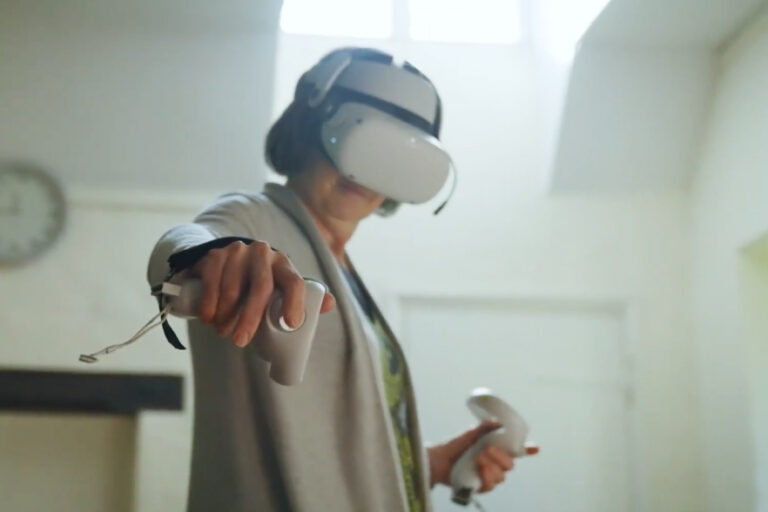
The world of work is an ever-changing environment, with the constant changes feeling sometimes impossible to keep up with. Although many of us eventually get used to these changes, for the visually impaired it is considerably harder to keep up, if the right tools aren’t in place. Making the workplace more assessable makes it an easier place to navigate for those who have challenges outside of work.
In the UK, more than 2 million people are living with sight loss. Of these, around 340,000 are registered as blind or partially sighted. The World Health Organisation stated that 2.2 billion people across the world have a near or distance vision impairment. Although there are so many individuals across the world living with a visual impairment, this group is still hugely underrepresented in the workplace. A study from late 2022 found that only one in four people with sight loss are currently in paid employment – suggesting something needs to be done.
With World Sight Day celebrated earlier in October, it is an opportunity to assess how businesses can become more accessible and inclusive. Fortunately, the emergence of advanced technology offers a promising solution to this challenge.
Utilising advanced technology: Creating more accessibility
The rapid development of innovative technologies presents businesses with powerful tools to create a more inclusive workplace environment. These advancements can be leveraged to significantly improve accessibility, which is a crucial foundational step that businesses must consider. By prioritising digital accessibility, organisations can foster an inclusive atmosphere that empowers individuals with visual impairments to thrive in the workplace.
One key example is the use of JAWS (Job Access With Speech) screen reading software, which is transformative for individuals with visual impairments. JAWS reads aloud everything on the screen, from text to menus, and even describes images when accessible. It enables users to control their computers entirely through the keyboard by providing auditory feedback as they navigate, type, and interact with applications. This comprehensive support allows users with visual impairments to write documents, browse the web, manage emails, and perform complex tasks just as efficiently as their sighted peers. By eliminating the need for visual interactions or mouse-based navigation, JAWS significantly enhances productivity while fostering independence and confidence among visually impaired employees.
Beyond assistive technology software, other accessibility-focused technologies are equally vital. For instance, the implementation of alt text on websites can make a significant difference. Alt text refers to the textual descriptions that are added to images, enabling screen readers to convey the visual information to users with sight loss. This simple yet impactful feature ensures that individuals who are visually impaired can fully engage with digital content, rather than being excluded.
Narrowing the employment gap with the latest technology
However, despite these advances in technology, the employment landscape for individuals who are visually impaired remains challenging. Firstly, legacy software systems are often still not fit for purpose, lacking the necessary accessibility features that allow individuals who are visually impaired to perform their jobs effectively. These outdated systems frequently struggle with screen reader compatibility, creating barriers in day-to-day tasks.
Secondly, there’s a clear correlation between this technological gap and the underemployment of individuals who are visually impaired. Many employers, aware that they lack the proper tools to support individuals who are visually impaired, may hesitate to hire from this community. This creates a cycle where limited job opportunities persist due to inadequate technological infrastructure.
Genesys and Lighthouse Works recently announced a partnership to directly addresses these challenges. By developing EquiVista, an application available on Genesys Cloud, we’ve created a solution that’s specifically designed with accessibility in mind. EquiVista offers a simplified, customisable user interface that adapts to individual visual abilities and integrates seamlessly with screen reading software like JAWS.
This innovation not only makes existing systems more accessible but also provides employers with the tools they need to confidently hire and support individuals who are visually impaired. By tackling both the technological and employment barriers simultaneously, the Genesys and Lighthouse Works partnership paves the way for increased job opportunities in the customer experience sector and beyond. It demonstrates that with the right tools, individuals who are visually impaired can excel in roles previously considered challenging, encouraging more businesses to create inclusive workplaces and tap into this underutilised talent pool.
Providing training and support for the visually impaired
Crucially, businesses must also provide comprehensive training and support to help individuals who are visually impaired integrate technologies into their workflows. Offering one-on-one guidance and ongoing technical assistance can help ensure a smooth transition and foster a sense of confidence and empowerment.
It’s essential that organisations take a proactive, personalised approach to training. Rather than assuming a “one-size-fits-all” solution, HR and IT teams should work closely with individuals who are visually impaired to understand their unique needs and preferences. This could involve demonstrating how to effectively use screen readers, magnification software, or voice command tools, and providing tailored troubleshooting support.
Importantly, this emphasis on training and support should extend beyond just the individual employee. It’s equally vital that businesses educate the broader workforce on accessibility best practices and foster a culture of empathy and inclusion. By helping sighted colleagues understand the assistive technologies in use and how to collaborate effectively, organisations can break down any lingering stigmas or misconceptions.
The future of accessible workplaces
World Sight Day once a year is a great prompt to start making change, but it doesn’t stop here. Making the workplace more inclusive should be a priority all year round. Using technology as a force for good will make the workplace a more inclusive and accessible place – leaving all individuals with equal opportunities in the workplace.

Eric Thomas
Eric Thomas leads the Diversity, Equity and Inclusion practice at Genesys. Prior to his current role, Eric served as Vice President, Global Delivery, in Genesys Professional Services.



